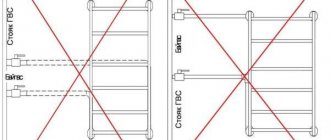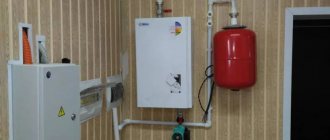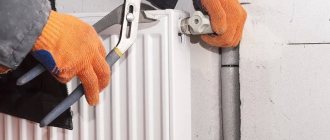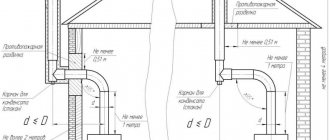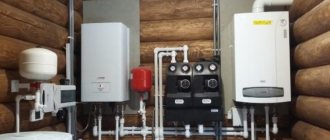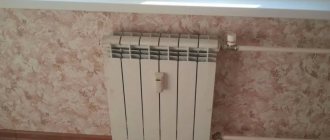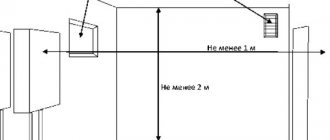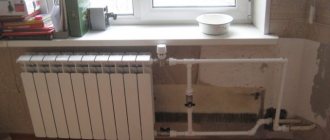Types of heated towel rails
The modern market offers a wide range of different models of devices for drying towels. According to the type of energy consumed, heated towel rails are divided into three main types:
- Water. In private homes, the device is connected to the heating circuit and functions only while the boiler is being used to heat the room. Water is used as a coolant. In apartments, it is possible to connect this type of heated towel rail to hot water supply.
- Electric. This model operates independently of the heating system. The device is heated by a heating element. To connect such a heated towel rail, an electrical outlet is required. You can use the device for drying things and additional heating of the room for any room in the house.
- Combined. The design of the heated towel rail combines a water circuit and electrical energy. The heating element heats the coolant liquid, which is the heat source in the device.
Based on the meter of location, a distinction is made between horizontal and vertical types of heated towel rails. On the modern market you can find corner and floor designs, which are especially relevant for small bathrooms.
The materials for making towel dryers can be:
- Steel. Devices made from this material have a low cost and many disadvantages - low wear resistance, susceptibility to corrosion, and the possibility of peeling off the chrome coating. The best option is stainless steel. Its cost is an order of magnitude higher, but at the same time the technical parameters of the product increase.
- Copper. Such heated towel rails are considered durable. The only drawback is the high price of copper products.
- Aluminum. This material has good thermal conductivity. Aluminum dryers are relatively inexpensive universal products.
- Brass. This material, like copper, is endowed with high wear resistance and resistance to corrosion. Due to the high thermal conductivity of drying towels made of brass, you can choose small sizes.
Copper heated towel rail
Heated towel rails are produced in various sizes. Standard devices are shaped like a snake or ladder. The variety of modern models allows you to choose a towel dryer of the most unusual design.
Upper and lower wiring of a two-pipe network
At the moment, wiring installation is done in two ways:
- Top
: the distribution pipeline is laid from above, an expansion tank is installed at the highest point of the heating circuit (insulated attic). This option is suitable for private houses and cottages with a hollow roof; - Bottom
: The “hot line” is installed in the basement or under-floor space. The return pipe for cooled water to the boiler should be located lower than the direct pipe. An upper air line is used to remove excess air from the network. In this case, the device itself must be mounted in a recess, because for uniform heat distribution, the batteries must be located above the boiler.
Both schemes are relevant for any type of arrangement of supply pipes. At the same time, the lower wiring is used mainly in multi-storey residential buildings, while the first is relevant for private houses and cottages.
There are several ways to connect water dryers: bottom, top, corner and side.
The most acceptable option is a side connection.
Such models can be adjusted to different installation locations. Also, such a connection will have a more aesthetic appearance, due to the fact that it will be almost invisible.
Before purchasing a device, you should find out the distance between the hot water supply outlets. Almost always it is 50 cm.
Requirements for connection diagrams
The installation of a heated towel rail is carried out according to a specific scheme, which is selected taking into account the characteristics of the model and the location of the pipeline in the room. The most common and effective is the side and bottom insert. Each option has its own connection features.
When using a towel dryer using the bottom cut-in method, the following must be taken into account:
- the heated towel rail should be located above the level of the lower outlet from the riser;
- along the straight sections of the heated towel rail pipes, the presence of depressions and protrusions, which can cause air accumulation in the system, is excluded;
- when using a bypass of an offset or narrowed type, the upper supply to the riser must be placed below the drying device;
- pipe sections hidden in the walls must be protected with heat-resistant insulation.
The lower connection diagram ensures the working process regardless of the direction of the water flow.
Installing a heated towel rail using a diagonal or side connection is more practical. The main condition for this type of connection is:
- no bends in the supply pipeline;
- the slope of the supplied pipeline must be at least 3 millimeters per meter of connection;
- when installing a heated towel rail at a short distance from the riser and using a pipe with a cross-section of 32 millimeters, a horizontal pipe connection is possible;
- The connection points for the towel dryer must be located between the upper and lower outlets of the vertical pipeline.
With a diagonal connection, air bleed is not required and any distance of the device to the riser is allowed.
What designs are there?
Heated towel rails come in different shapes. When choosing them, people are often guided solely by aesthetics, which is not entirely justified. These devices work normally with good water circulation, but not all models provide such circulation. With some you have to spend a long time trying to find the right connection diagram, otherwise they simply refuse to work.
So, all heated towel rails can be divided into four groups:
- U-shaped or U-shaped. The simplest models, basic connection (lateral). Ideally, when replacing the old one, you find a model with the same center distance. Then, if you're lucky, you won't even have to redo the bends.
- Ladder. Modern designs with a certain number of crossbars. Also a good option from a hydraulic point of view. The connection can be bottom, side or diagonal. But it is not chosen arbitrarily, but according to a set of conditions (where the supply comes from, location relative to the riser).
- Snake. Another classic model with side connection. Installing a heated towel rail of this type, as a rule, does not present any problems.
Types of heated towel rails
- Complex shape. There are very unusual heated towel rails. They can even be an interior decoration, but their proper connection is a problem. As a rule, consultation with a competent specialist, a plumber who is well versed in hydraulics, is required. As you understand, finding one is not an easy task.
It often happens that after installing a heated towel rail it simply does not work. If the error is serious, the riser to which it is connected also stops working. Therefore, it is necessary to know and follow the connection rules.
Options for technical solutions
Installation of a heated towel rail in a private home can be carried out in several ways - connecting to the main heating system, installing on a separate circuit or connecting to a hot water supply. Each option has its advantages and disadvantages.
Heated towel rail on a separate heating circuit
This installation option is suitable for any model of water heated towel rails. The device is connected on a separate closed circuit together with the pumping group.
The advantage of using this installation method is:
- providing heating of the bathroom without the use of radiators;
- convenient use regardless of the time of year;
- the ability to install any design of a water heated towel rail, which allows you to implement any design solutions.
Heated towel rail on a separate heating circuit
The disadvantages of connecting a device for drying towels to a separate heating branch often include the complexity of installation work. To install the device, additional equipment is required, which includes a pump, a separate collector outlet and automation.
Connecting the structure to the main heating circuit
This method of connecting a heated towel rail to the heating system is less expensive. But for convenient use of the device, it is recommended to additionally install a temperature limiter. This is due to the strong heating of the coolant in the supply circuit, which often causes discomfort when touching the dryer with your hands.
Using the option of connecting a heated towel rail to the main heating circuit has its advantages:
- the ability to use the device as the main heating of the bathroom;
- low installation costs;
- Application for any models with liquid coolant.
The disadvantage of this installation is that the device is turned off in the summer along with the heating system.
Hot water connection
This type of installation involves connecting a heated towel rail to a central hot water supply. The option is quite economical, since it does not require the installation of additional devices and is successfully used in apartments.
The advantages of this type of connection include:
- uninterrupted use with year-round supply of hot water;
- simplicity of installation work, no additional costs.
Connecting a heated towel rail to hot water has its disadvantages:
- for installation, it is allowed to use only certain models of dryers made of standard stainless steel;
- limited possibility of use as the main heating of the bathroom.
The power of dryer models that are designed to be connected to hot water supply is no more than 200 watts, so installation in a room without radiators or heated floors is impractical.
Typical mistakes of independent craftsmen
When, with a side or bottom connection, the lower outlet is located above the extreme point of the PS, a stagnation zone is formed between the bottom of the device and the connection point of the lower outlet.
This is a consequence of the fact that the cooled liquid, having dropped down, cannot get back into the riser due to the pressure on it from a column of hot water with a lower specific gravity. As long as the permissible height difference between the bottom outlet and the bottom of the heated towel rail is not exceeded, the device works, and after that the circulation in it stops.
Circulation will also stop if there is a bend formed by the upper pipe. The only way to make such a scheme work is by inserting a Mayevsky tap to periodically bleed off the accumulated air. Sometimes a loop is made in the upper pipe, laying it behind the ceiling trim, and the lower pipe is walled into the floor.
Air will accumulate at the top, and the cooled water in the unit will be blocked in the lower loop located in the floor. The movement of the coolant will stop completely.
Materials for work
In private homes, water heated towel rails are mainly installed, which are connected directly to the heating system.
When connecting the device, you must use the following materials:
- shut-off valves;
- fittings – couplings, bends, bends;
- air vent valve;
- mounting tow or tape;
- fastening elements - dowels, brackets, bolts, screws.
To connect a heated towel rail in a private house, you will need an installation tow.
Experts recommend installing a bypass on the heated towel rail, which is a piece of pipe with tees at the edges. In this case, ball valves are mounted at the ends of the dryer.
Where to connect and where to hang
You can connect a water heated towel rail to both the hot water riser and the heating system. If both of these options are available, DHW is usually chosen
There are three reasons for this: there is less hassle with permission to connect, you can connect at any time of the year (agree with the management company to turn off the riser and that’s it) and, most importantly, such a heated towel rail heats up all year round
If there is no hot water supply in the house, you will have to connect to the heating riser. This requires permission from the Criminal Code and a project. Buy a heated towel rail (preferably a simple design), go to the housing office with its passport (copy), write an application. If permission is given, order the project (you will also need a copy of the passport with connecting dimensions). Then, according to the project, you do it yourself or hire performers (plumbers from the housing office, as an option). Call representatives of the Housing Office for acceptance.
To ensure that the “towel” always warms up without problems, all connections are straight, without arcs or pockets
When determining where to install the heated towel rail, questions may still arise about what height it should be hung. If you have a choice, it is most convenient to place it so that it is at head level and below. This is if you install a U-shaped or snake. If we are talking about “ladders” of great height, the top bar is placed at the level of the heat of the raised hand (approximately 190-200 cm).
When choosing a location for installing a heated towel rail, you must also take into account the distance from the riser. In principle, the closer to the riser, the better - the greater the chance that it will work. But, it can be attributed to a meter or so only if the following conditions are met:
- low hydraulic resistance of the heated towel rail (simple shape and cross-section 1″ or 3/4″),
- sufficient pressure (2 atm or more)
- drain pipes of normal diameter (one step smaller than the riser).
At the same time, be sure to follow other connection rules. Then there will be chances that such a “remote” device will work normally.
Rules and procedures for connecting a heated towel rail
Installation of the device in the heating circuit is carried out by inserting a pipeline. Before installation work, the water supply is turned off and the coolant is drained from the system.
Connecting the water towel dryer is carried out in the following sequence:
- the location of the device is determined and appropriate measurements are taken;
- threads are cut at the ends of the pipeline;
- The bypass is assembled, tees and a shut-off valve are fixed on the pipe;
- to ensure complete tightness of the connections, tow or a special thread is used;
- Ball shut-off valves are installed on the taps, to which the device inputs are connected.
The valves connected to the heated towel rail are left in the open position, and the shut-off mechanism on the bypass is closed. After connecting the dryer, it is necessary to fill the system with water and check the joints under pressure for leaks.
Convectors with forced convection Klima TKV
TKV floor convectors operate on the principle of forced ventilation, i.e. the air flow is increased using a fan. Designed for primary and secondary heating of premises where it is necessary to use devices with high thermal power. Thermal power depending on the size of the convector is from 0.4 kW to 8 kW. In convectors with forced convection “Klima TKV”, air movement is provided by a built-in tangential fan. Cold air accumulating near the floor is sucked in by a fan and, heated as it passes through the heat exchanger, enters the room. Forced air circulation and its increased volume involved in movement contributes to the rapid and uniform heating of your room. Compared to heating devices operating on the principle of free convection, the Klima convector significantly increases overall comfort.
Technical characteristics of Klima TKV:
- Convector heights: 82, 105, 140 mm
- Convector length: from 800 to 5000 mm
- Convector depth: 200, 300, 400 mm
- Working pressure: 10 atm.
- Maximum pressure: 25 atm.
- Maximum coolant temperature: 100°C
- The heat exchanger material for built-in convectors IMP Klima is made of copper pipes 16×1.0 mm, on which ribbed aluminum plates 83×50 mm are located
- Connection to water pipes is made using a connecting nut with internal thread R ½"
- The tangential fan of built-in convectors IMP Klima TKV consists of a low-power single-phase motor (220 V, 33 W, max 0.25 A) with propellers on both sides of the motor.
- The fan is protected by a protective mesh, which prevents mechanical damage
- Thermal power is indicated for temperature conditions of 90/70/20°C (convector operating mode - NORM)
- Certificate of conformity: ROSS SI.AB28.B06253
Operating principle of Klima TKV convectors Each convector is equipped with one or more tangential fans (their number depends both on the length of the convector and on the specific model - it is necessary to specify when ordering), which force air from the room directly onto the heat exchanger, where the air is heated and exited directly on the window. This ensures better heating of the glass, which prevents the formation of icing and condensation on them.
The fans can operate in three modes: minimum, medium and maximum speed, depending on the required power, and they can also be turned off. To control the operation of fans depending on the room temperature, it is necessary to additionally install a wall-mounted room thermostat Hidria 09T or 037. One thermostat can simultaneously control several fans or convectors, if they are located in the same room - the complete set must be specified when placing an order.
Recommendations for installation work
The efficiency of a heated towel rail depends on its correct installation. To avoid future problems with the operation of the device, it is recommended to take into account the following recommendations during the installation process:
- The diameter of the pipeline should not exceed the cross-section of the heated towel rail itself. Compliance with this requirement helps prevent an increase in pressure in narrowing areas.
- Installation of adapters in the presence of different sections of pipelines and pipes is allowed if the diameter of the towel dryer is smaller than the pipes. Violation of this installation procedure can cause a significant increase in pressure in the device, which will lead to an emergency.
- To remove air from the device, ensure normal operating process, as well as the possibility of repair, it is recommended to install a bypass. In order not to disrupt the good circulation of the coolant, shut-off valves should not be installed on the jumper.
- A distance of 4 centimeters must be maintained from the wall surface to the heated towel rail. If the diameter of the device pipes exceeds 25 millimeters, then it should be increased to 7 centimeters.
- The location of the bottom of the dryer from the floor should be 90 centimeters. The optimal height is considered to be 120 centimeters.
Experts recommend using materials of the same origin when installing a heated towel rail. The combination of different metals can lead to the process of structural destruction. Teflon gaskets will help eliminate problems with corrosion at joints.
The method of installing a heated towel rail in a private home depends on the type of device chosen and the complexity of its design. Taking into account all the installation requirements, you can connect the towel dryer yourself.
How does the shape of the device affect installation?
The efficiency of water circulation and the absence of stagnant or airy areas depend on the shape of the heated towel rail.
The most effective are U- or M-shaped structures that do not have complex intersections or bends.
Water enters them from one end of a curved pipe and leaves the other without changing its speed or stopping.
However, modern substation designs, made in the form of ladders or in the form of complex spatial lattices, are more convenient for operation. They provide more options for drying towels, but require proper connection.
